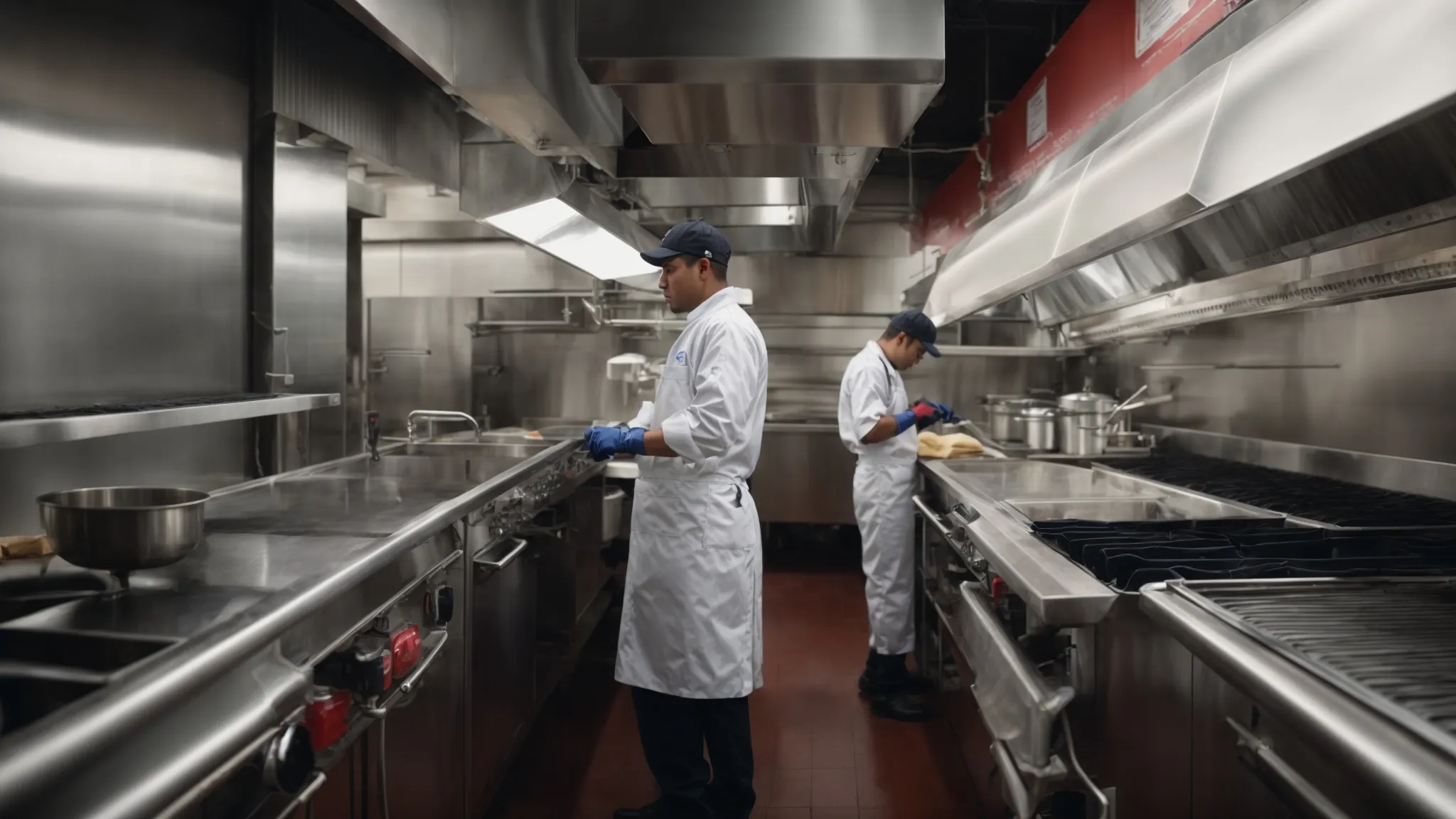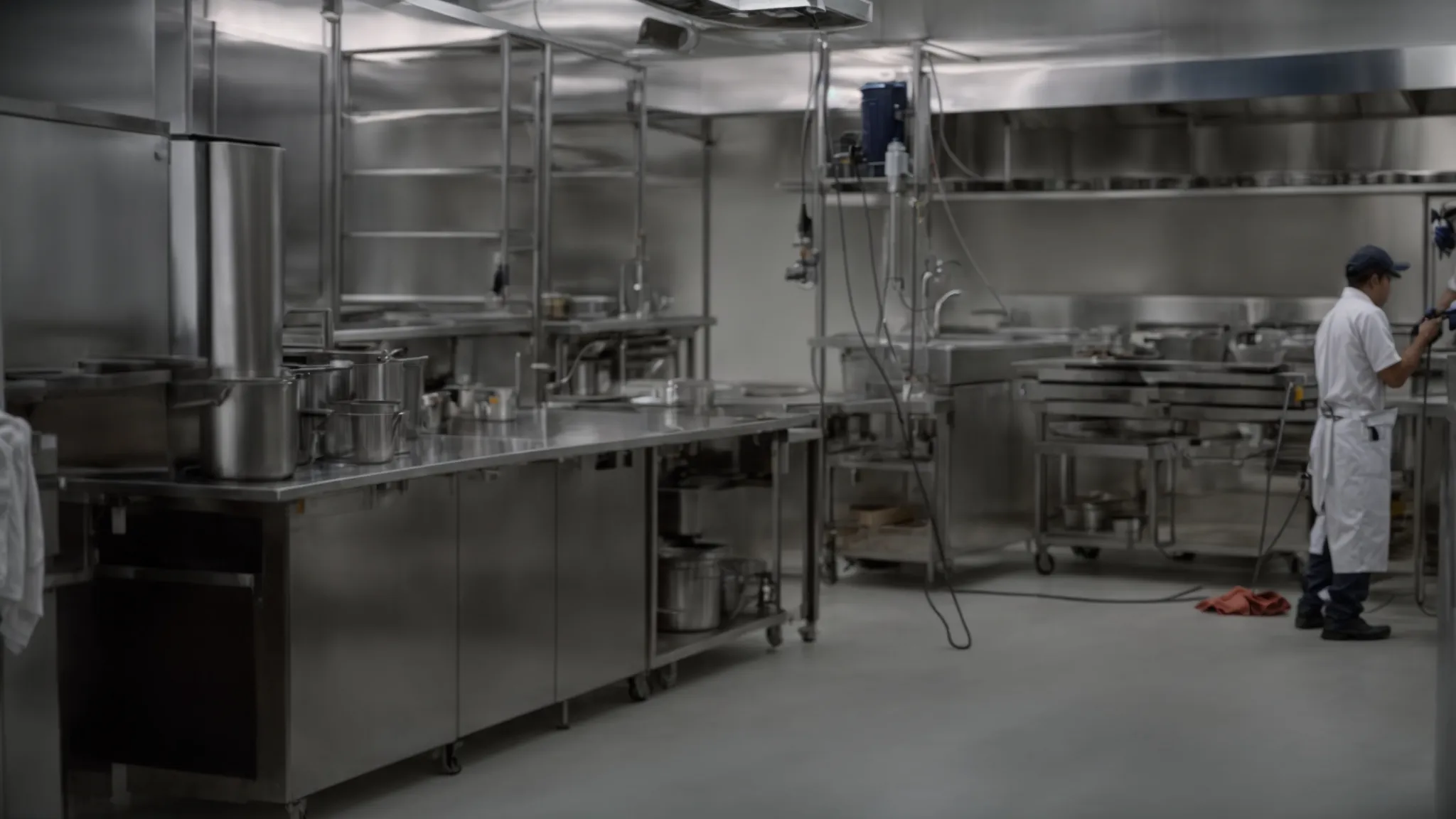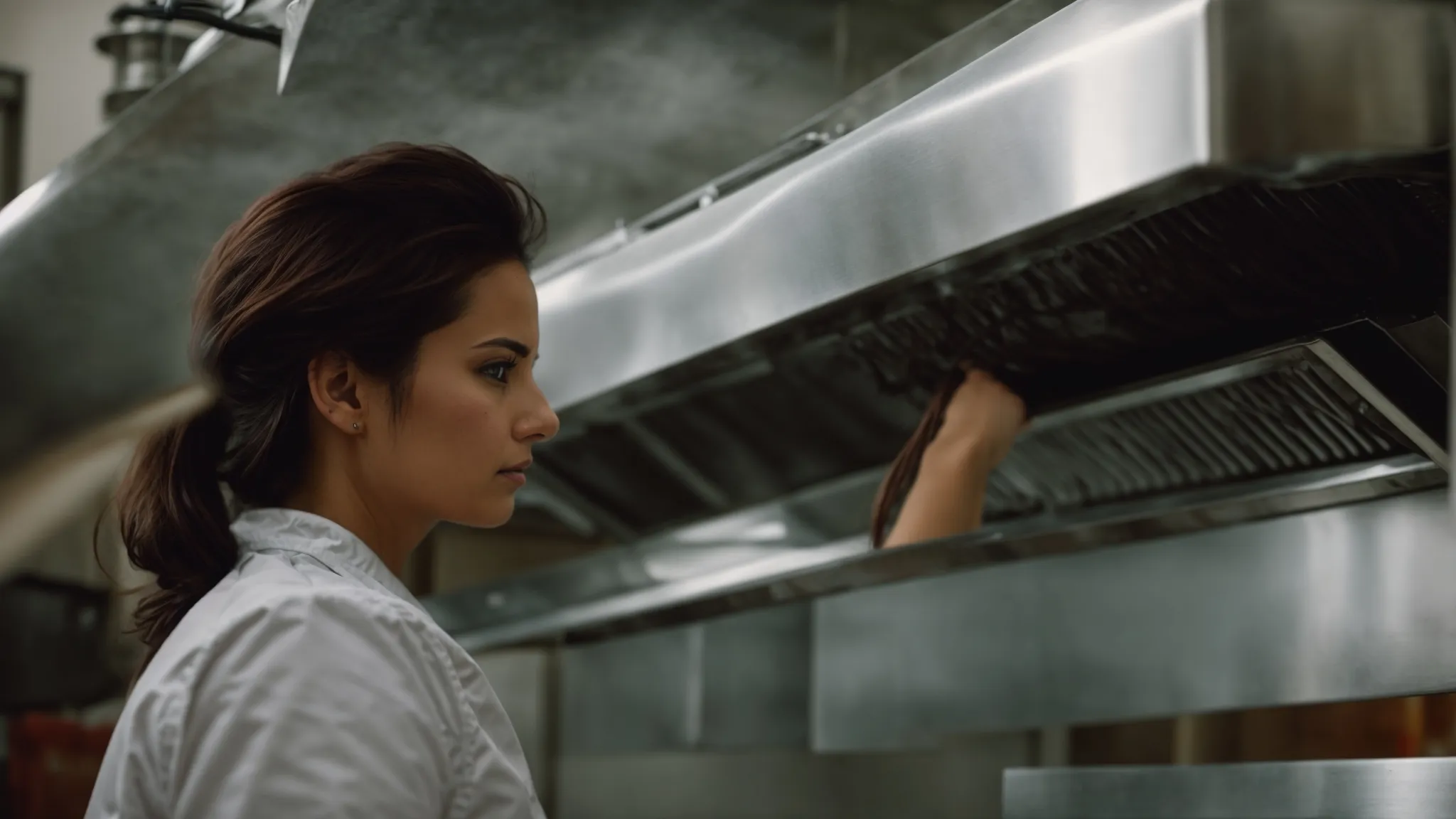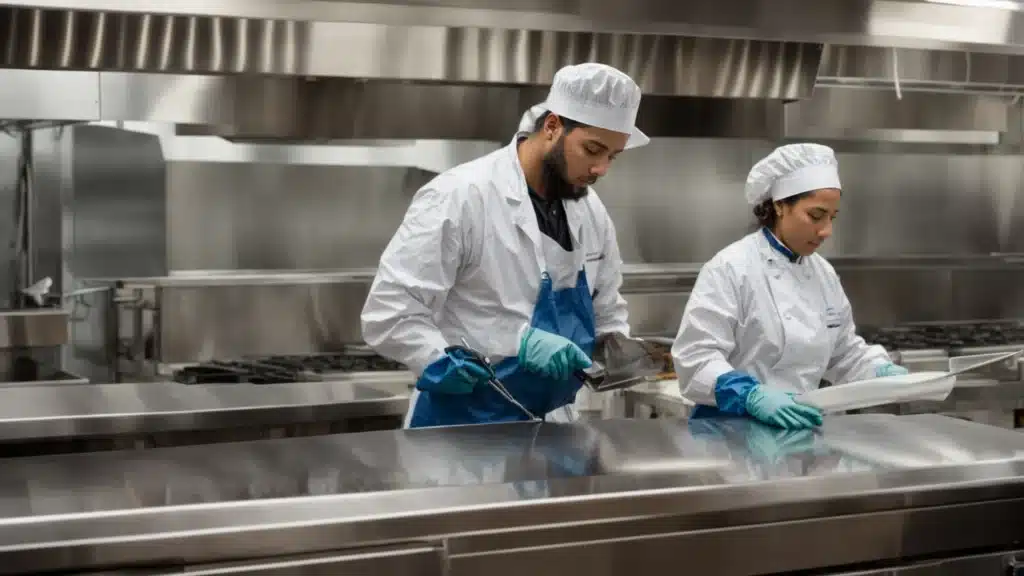Understanding the Legal Requirements for Hood and Kitchen Exhaust Cleaning in Ontario Canada
Navigating the intricate maze of legal standards for hood and kitchen exhaust cleaning in the heart of Ontario, Canada, becomes akin to traversing the complexities of a grand culinary symphony, where every note of regulation harmonizes with the crescendos of public safety and health.
Amidst the bustling kitchens of Toronto, Mississauga, Oshawa, and beyond, these regulations serve as the sheet music for a safer dining experience, ensuring every vent, duct, and hood sings in tune with Ontario’s stringent health codes.
Restaurant owners, chefs, and facility managers find themselves at the conductor’s stand, orchestrating an ensemble of cleanliness, compliance, and culinary excellence.
In this article, we’ll unravel the legal intricacies surrounding hood and kitchen exhaust cleaning, guiding you through a harmonized path towards compliance and exemplary kitchen hygiene.
Keep reading to uncover the steps to ensure your kitchen’s performance hits every note of Ontario’s health and safety standards.
Key Takeaways
- Regular Hood and Kitchen Exhaust Cleaning Is a Legal Mandate in Ontario, Aligned With Health and Safety Standards
- Compliance With NFPA-96 Standards and Ontario Fire Code Regulations Is Crucial for Commercial Kitchens to Prevent Fire Hazards and Maintain Air Quality
- Certification and Documentation of Cleaning Practices Are Essential Aspects of Legal Adherence and Operational Integrity for Culinary Establishments
- The Consequences of Non-Compliance With Hood and Kitchen Exhaust Cleaning Regulations Include Hefty Fines, Legal Repercussions, and Potential Damage to Reputation
- Continuous Learning and Professional Consultations Are Vital for Staying Updated With the Evolving Legal Framework and Ensuring Kitchens Meet Health and Safety Regulations
Introduction to Ontario’s Regulations for Kitchen Exhaust Cleaning

In the heart of Canada, nestled among the bustling cities and serene landscapes of Ontario, rests the cornerstone of public health and safety in the culinary sector — the Toronto Hood Cleaning province’s stringent health and safety laws governing hood and kitchen exhaust cleaning.
These regulations serve as a beacon of compliance for food establishments, weaving a tapestry of responsibility and diligence.
By adhering to such mandates, eateries not only safeguard the well-being of their patrons but also hoist their banner high in the realm of public trust and excellence in health standards.
The significance of compliance transcends mere legal obligation; it embodies a pact with society, ensuring that every meal served is a testament to cleanliness and safety.
Overview of Ontario’s Health and Safety Laws
In Ontario, the labyrinth of health and safety laws enshrouding commercial kitchens is more than a mere checklist; it’s a robust foundation ensuring the safety and wholesomeness of the culinary landscape. These statutes intertwine with the operations of food establishments, mandating periodic hood and kitchen exhaust cleanings to mitigate hazards such as fire risks and bacterial contamination.
At the heart of these regulations stand the stringent codes set forth by the National Fire Protection Association (NFPA) and local health authorities. The regulations mandate that commercial kitchens adhere to a prescribed schedule for cleaning their exhaust systems, based on the volume of cooking and type of food being prepared:
| Type of Cooking | Recommended Cleaning Frequency |
|---|---|
| High-volume cooking | Quarterly |
| Moderate-volume cooking | Semi-annually |
| Low-volume cooking | Annually |
Importance of Compliance for Food Establishments
Ensuring compliance with Ontario’s kitchen exhaust cleaning regulations is not just about ticking a box on a regulatory checklist; it’s about embedding a culture of safety and hygiene within the fabric of a food establishment. This adherence acts as a shield, safeguarding against the scourge of fire hazards and the menace of bacterial invasions that threaten the sanctity of any culinary space.
Furthermore, it crystallizes a restaurant’s commitment to the health and safety of its patrons, thereby elevating its reputation among the constellation of eateries across the region. Compliance is not merely a mandate but a vital investment in a restaurant’s future, ensuring its doors remain open, welcoming guests into a haven where culinary delights meet the highest standards of cleanliness:
- Protecting against the risk of devastating fires fueled by accumulated grease.
- Diminishing the presence of harmful bacteria and improving overall air quality.
- Upholding a restaurant’s integrity and trustworthiness in the eyes of regulatory authorities and patrons alike.
Navigating the labyrinth of Ontario’s culinary safety standards opens the door to a world of clarity and compliance. Let’s sharpen our focus on the essence of Hood Cleaning regulations that keep the heartbeat of Ontario’s kitchens pulsing with vigor.
Key Legal Requirements for Hood Cleaning in Ontario

In Ontario, the commandments governing hood and kitchen exhaust cleaning are not suggestions but legally binding imperatives, a clarion call to ensure safety and cleanliness in commercial kitchens.
Grasping the nuances of the National Fire Protection Association’s (NFPA) 96 standards within the framework of Ontario’s regulations is fundamental for every culinary establishment committed to excellence.
It’s a realm where the frequency of cleaning isn’t arbitrary but meticulously dictated by the Ontario Fire Code, providing a tailored approach to risk management based on the operational volume and nature of food service.
Beyond the mechanics of cleaning lies the bedrock of compliance – documentation and certification.
These requirements are not mere paperwork but the physical manifestation of a restaurant’s adherence to standards, its shield against legal repercussions, and its commitment to patrons’ safety and health.
This trifecta of understanding NFPA-96 standards, adhering to the prescribed cleaning frequency, and embracing the critical role of documentation and certification, shapes the cornerstone of legal compliance for hood cleaning in Ontario.
Understanding NFPA-96 Standards in Ontario Context
In the tapestry of regulations that envelop Ontario’s culinary sector, the NFPA-96 standards emerge as the guiding beacon, illuminating the path toward lawful compliance for hood and kitchen exhaust cleaning. This comprehensive set of guidelines, tailored specifically to combat the hazards inherent in commercial kitchens, delineates the meticulous procedures and safety measures essential for guarding against fire and ensuring air quality.
Charting the course within Ontario’s legislative landscape, the adoption of these NFPA-96 standards signifies a commitment to the highest echelons of health and safety. It empowers establishments to navigate the complexities of exhaust system maintenance with precision, thereby reinforcing the wall of protection around patrons, staff, and property. The essence of these standards, when distilled through the lens of Ontario’s rigorous enforcement, becomes a cornerstone of operational integrity for restaurants and culinary establishments.
Frequency of Cleaning as Per Ontario Fire Code
In the meticulously organized framework of Ontario’s Fire Code, the frequency of exhaust system cleanings is not left to ambiguity but is explicitly defined, serving as a compass for commercial kitchens across the province. This regulation establishes the intervals at which cleaning must take place and adjusts them in accordance with the establishment’s operational volume and type of cooking. NFPA-96 standards embody the preventive ethos.
Adherence to these designated intervals is paramount, acting as a linchpin in the overarching strategy to avert fire hazards and maintain air quality within the culinary sphere. Ontario’s Fire Code, by mandating such precision in cleaning schedules, underscores its commitment to safeguarding not only the physical premises of food establishments but also the health and well-being of every patron and employee within.
Documentation and Certification Requirements
In the realm of ensuring compliance with Ontario’s hood and kitchen exhaust cleaning regulations, securing and maintaining up-to-date documentation and certification stands as a pivotal element. This practice not only solidifies an establishment’s adherence to health and safety standards but also serves as a tangible testament to their commitment to risk management and operational integrity.
For culinary establishments navigating the intricate waters of Ontario’s legal landscape, procuring certification from accredited professionals underscores the seriousness with which they approach fire safety and air quality within their kitchens. This certification, a beacon of diligence, is not merely a piece of paper; it is the embodiment of an establishment’s dedication to the well-being of its patrons and the longevity of its operation.
The spotlight now shifts from the forest of legalities to the bright stage of selecting a champion cleaner. Let’s embark on the quest to find the certified ally your kitchen deserves.
Choosing a Certified Cleaning Company

In the intricate dance of maintaining a culinary establishment’s compliance with Ontario’s rigorous health and safety laws, the choice of a cleaning company becomes a pivotal step.
This decision, far more than a mere operational consideration, becomes a testament to a restaurant’s commitment to safety, cleanliness, and legal adherence.
Venturing into the realm of exhaust cleaning requires a keen eye for detail, particularly in verifying the certification of a service provider and probing the depth of their experience and expertise.
Therefore, understanding the labyrinth of certification nuances and arming oneself with pointed questions before engaging a cleaning service is not just due diligence; it’s an essential component of ensuring the safety and well-being of patrons and staff alike.
This section delves into the critical processes of verifying the credentials of a hood and kitchen exhaust cleaning service and outlines the salient inquiries that should precede the hiring decision, thereby illuminating the path to a partnership that uplifts an establishment’s standards of hygiene and safety.
How to Verify Certification of a Cleaning Service
Embarking on the path to ensure a culinary establishment’s compliance with Ontario’s stringent health and safety laws necessitates a critical step: the selection of a hood and kitchen exhaust cleaning service that holds the requisite certification. It begins with seeking proof of certification from potential service providers, which serves as a tangible guarantee of their adherence to industry standards and regulations.
Moreover, the investigative journey into a service’s certification should also explore the depth of its affiliation with recognized industry associations, such as the National Fire Protection Association (NFPA) or local regulatory bodies. This scrutiny ensures that the company’s practices align with the latest safety protocols and technological advancements:
| Verification Step | Action | Expected Outcome |
|---|---|---|
| Request Proof of Certification | Ask for documents that validate the company’s certification status. | Confirmation of the company’s legitimacy and compliance with regulatory standards. |
| Check Industry Association Membership | Inquire about membership in recognized associations like NFPA. | Assurance of the company’s commitment to industry best practices and safety standards. |
By adhering to these steps, establishments not only safeguard the health and safety of their patrons and staff but also fortify their compliance with Ontario’s legal framework for kitchen maintenance and safety.
Questions to Ask Before Hiring a Cleaning Service
Before welcoming a hood and kitchen exhaust cleaning service into the fold of your culinary kingdom, embarking on the journey with a series of preparatory questions is essential. Probing the depths of their experience with similar commercial environments in Ontario reveals insights into their adeptness and readiness to navigate the unique challenges your kitchen presents. This inquiry not only assesses their expertise but also aligns expectations, fostering a partnership built on mutual understanding and skillful execution.
Another pivotal inquiry involves delving into their approach to emergency scenarios and unforeseen complications, a landscape where the theoretical meets the practical. Understanding how a prospective service navigates the rough waters of sudden issues, from equipment failures to unexpected grease buildup, offers a window into their problem-solving prowess and reliability. It’s this prism of preparedness and adaptability that transforms a cleaning service from a mere contractor into a trusted ally in maintaining the high standards of hygiene and safety your establishment and Ontario’s regulations demand.
Selecting a certified cleaning crew is just the first step. Now, we embark on a critical journey, ensuring every aspect aligns with Ontario’s rigorous safety standards.
Ensuring Compliance With Ontario’s Safety Standards

In the intricate tapestry of Ontario’s culinary industry, ensuring compliance with the province’s health and safety standards represents a crucial step toward safeguarding both patrons and the longevity of food establishments themselves.
This necessitates an unwavering commitment to a duo of critical practices: the meticulous routine inspection of hood and kitchen exhaust systems, and the diligent maintenance of comprehensive records.
Together, these practices form the backbone of a proactive strategy, enabling restaurant owners to not only meet but surpass the stringent regulations set forth by Ontario’s health and safety laws.
Acknowledging the significance of these responsibilities, the following sections will explore the dynamics of establishing an effective routine inspection checklist and adopting robust record-keeping practices, both of which empower restaurant owners to navigate the complexities of audit and compliance with confidence.
Routine Inspection Checklist for Restaurant Owners
Restaurant owners in Ontario embark on a vigilant quest to ensure their kitchens operate not just within the bounds of culinary creativity but also within the stringent parameters of safety and health regulations. A keystone in this endeavor is the development of a comprehensive routine inspection checklist, specifically tailored for the scrutiny of hood and kitchen exhaust systems. This document serves as a guiding light, ensuring every nook and cranny of the kitchen’s ventilation system is meticulously examined for compliance and cleanliness.
Within the restaurant’s heart lies the crucible of its operations—the kitchen. Here, the importance of a routine inspection checklist transcends mere regulatory adherence, morphing into a vital ritual that safeguards the establishment against the twin threats of fire hazards and contamination. It empowers owners to take preemptive measures against potential violations, nurturing an environment where culinary excellence and safety walk hand in hand.
Record-Keeping Practices for Audit and Compliance
In the realm of compliance within Ontario’s culinary landscape, meticulous record-keeping emerges as a pivotal practice. This process involves maintaining comprehensive logs that chronicle each cleaning operation, documenting the date, scope, and particulars of the service provided. Such records not only serve as proof of adherence to both local laws and NFPA-96 standards but also stand as a beacon of diligence in the face of audits.
By ensuring the longevity and integrity of these documents, restaurants create an unbreakable chain of accountability that extends from the kitchen to the corridors of legal compliance. It is through this meticulous documentation that establishments can navigate the intricacies of regulatory audits, presenting their cleaning history as a testament to their unwavering commitment to health, safety, and culinary excellence.
As we turn the page on adherence, a new chapter beckons with cautionary tales. Prepare to unravel the consequences of neglecting Ontario’s stringent safety mandates.
Penalties for Non-Compliance in Ontario

Every food establishment operating within this jurisdiction must be aware of the consequences of non-compliance in the intricate web of strict health and safety laws for commercial kitchens.
The shadow of penalties and fines looms large over those who overlook the importance of regular hood and kitchen exhaust cleaning, serving as a stark reminder of the legal and financial consequences that ensue.
Through a close examination of case studies, we can illuminate the dire consequences faced by businesses that sidestep these critical regulations, emphasizing the imperative nature of adherence to safeguard against the dual threats of legal repercussions and compromised public safety.
Overview of Penalties and Fines
In the legal landscape of Ontario, Canada, the consequences of neglecting hood and kitchen exhaust cleaning regulations manifest in the form of stringent penalties and hefty fines. These punitive measures serve as a stark reminder to food establishments of the financial and reputational risks inherent in non-compliance, ensuring that the importance of kitchen exhaust system maintenance is not taken lightly.
Authorities in Ontario enforce these regulations with rigorous scrutiny, employing fines as a tool to underscore the gravity of compliance. The imposition of such fines not only impacts the immediate financial standing of a restaurant but also conveys a broader message about the seriousness with which health and safety standards are regarded in the province’s culinary industry.
Case Studies: Consequences of Ignoring Cleaning Regulations
In a recent enforcement action that has become a cautionary tale across Ontario, a renowned eatery in Toronto faced severe consequences for neglecting their hood and kitchen exhaust cleaning responsibilities. Their oversight led to a significant fire, propelled by accumulated grease, causing extensive property damage and temporary business closure:
- The aftermath of the fire prompted an immediate investigation, revealing the neglect.
- Authorities imposed hefty fines on the establishment for non-compliance with Ontario’s stringent health and safety laws.
- The eatery’s reputation suffered, leading to a decline in patronage once it reopened.
Another case unfolded in Mississauga, where a popular diner was subjected to unannounced health inspections. Inspectors discovered an improperly maintained kitchen exhaust system, resulting in the diner’s immediate shutdown and the imposition of fines: This incident highlights the direct link between adherence to cleaning regulations and the uninterrupted operation of food establishments in Ontario, underscoring the gravity of compliance.
The stakes are high, yet the game is far from over. Buckle up, as we dive into the realm of mastering Ontario’s cleaning regulations with finesse.
Staying Updated With Ontario’s Cleaning Regulations

In the ever-evolving landscape of Ontario’s health and safety regulations pertaining to hood and kitchen exhaust cleaning, staying abreast of the latest mandates and advancements is crucial for every culinary establishment’s operational integrity.
Navigating this terrain demands not only vigilant observation but also the leveraging of resources designed to foster continuous learning and updates.
Equally important is the role of professional consultations, offering tailored advice and insights that align with the specific needs of a restaurant or commercial kitchen.
This dual approach ensures that establishments not only comply with current regulations but also anticipate future changes, maintaining their commitment to health, safety, and excellence in culinary service.
Resources for Continuous Learning and Updates
Navigating the complex labyrinth of Ontario’s legal framework concerning hood and kitchen exhaust cleaning necessitates a commitment to lifelong learning. Culinary establishments can tap into a rich vein of knowledge by subscribing to newsletters from authoritative bodies like the National Fire Protection Association (NFPA) and local health departments, ensuring they are always at the forefront of the latest industry practices and regulatory changes.
Engaging with professional cleaning companies that specialize in hood and kitchen exhaust services within Ontario offers another layer of insight. These entities often host workshops, seminars, and webinars, providing valuable platforms for restaurateurs to glean practical advice, understand nuanced regulatory interpretations, and stay aligned with best practices ensuring compliance and safety in their kitchens.
Importance of Professional Consultations
Professional consultations illuminate the complex labyrinth of Ontario’s cleaning regulations for hood and kitchen exhaust systems, offering a beacon of clarity amidst the fog of legal stipulations. These tailored discussions empower culinary establishments to navigate the regulatory terrain with confidence, ensuring that every aspect of their cleaning protocols aligns with current standards and anticipates impending updates.
By engaging with experts in the field, restaurant owners and commercial kitchen operators secure an invaluable ally in the quest for compliance. These consultations not only demystify the nuances of the law but also translate them into actionable strategies, safeguarding establishments against the pitfalls of non-adherence and reinforcing their commitment to public health and safety.

